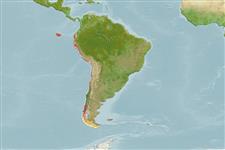Common names from other countries
Élasmobranches (requins et raies) (sharks and rays) >
Carcharhiniformes (Ground sharks) >
Triakidae (Houndsharks) > Triakinae
Etymology: Mustelus: Latin for weasel, an ancient name for sharks, possibly referring to the pointed snouts, swift movements and/or rapacious feeding behavior of smaller predatory sharks [strictly not tautonymous with Squalus mustelus Linnaeus 1758 since type was designated by the ICZN]. (See ETYFish); mento: From the Latin mentum, chin, referring to its “long muzzle”. (See ETYFish).
More on author: Cope.
Environment: milieu / climate zone / depth range / distribution range
Écologie
marin démersal; profondeur 16 - 50 m (Ref. 244). Subtropical; 2°N - 57°S, 95°W - 67°W (Ref. 244)
Eastern Pacific: Peru to southern Chile, including the Galapagos and Juan Fernández Islands.
Length at first maturity / Taille / Poids / Âge
Maturity: Lm 88.0, range 86 - 90 cm
Max length : 141 cm TL mâle / non sexé; (Ref. 122662)
Description synthétique
Clés d'identification | Morphologie | Morphométrie
Adults marked by small white spots but sometimes plain colored, while young specimens marked with dark colored bars (Ref. 6032).
An inshore and offshore shark found on the continental and insular shelves (Ref. 244). Ovoviviparous, with 7 young in a litter. Size at birth about 30 cm. Utilized for human consumption.
Ovoviviparous, embryos feed solely on yolk (Ref. 50449). Distinct pairing with embrace (Ref. 205).
Compagno, L.J.V., 1984. FAO Species Catalogue. Vol. 4. Sharks of the world. An annotated and illustrated catalogue of shark species known to date. Part 2 - Carcharhiniformes. FAO Fish. Synop. 125(4/2):251-655. Rome: FAO. (Ref. 244)
Statut dans la liste rouge de l'IUCN (Ref. 130435)
CITES (Ref. 128078)
Not Evaluated
Menace pour l'homme
Harmless
Utilisations par l'homme
Pêcheries: hautement commercial
Outils
Articles particuliers
Télécharger en XML
Sources Internet
Estimates based on models
Preferred temperature (Ref.
115969): 9.7 - 20.5, mean 11.4 (based on 32 cells).
Phylogenetic diversity index (Ref.
82804): PD
50 = 0.5000 [Uniqueness, from 0.5 = low to 2.0 = high].
Bayesian length-weight: a=0.00214 (0.00126 - 0.00364), b=3.14 (3.00 - 3.28), in cm Total Length, based on LWR estimates for this species & Genus-body shape (Ref.
93245).
Niveau trophique (Ref.
69278): 4.1 ±0.03 se; based on food items.
Résilience (Ref.
120179): Très faible, temps minimum de doublement de population supérieur à 14 ans (Fec=7).
Fishing Vulnerability (Ref.
59153): Very high vulnerability (85 of 100).
